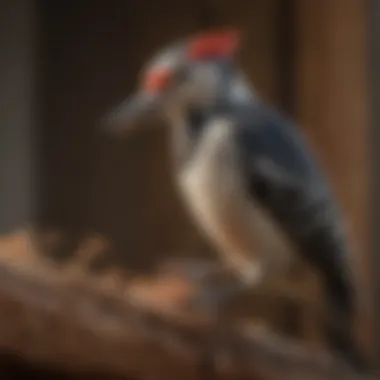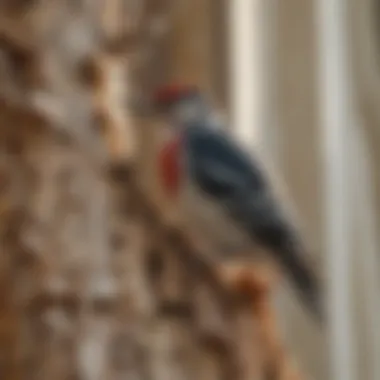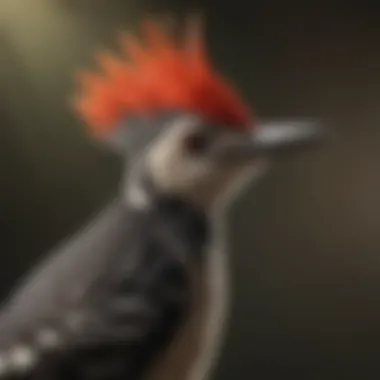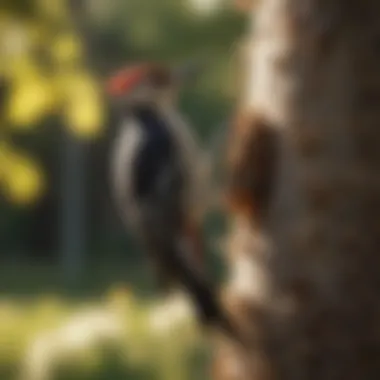Understanding Woodpecker Pests: Identification and Management


Intro
Woodpeckers are fascinating birds. Their drumming sound is often heard in wooded areas. However, in urban and suburban settings, these birds can become pests. They can damage structures and create frustrating situations for homeowners. Understanding woodpeckers, particularly when they become pests, is important for prevention and management. This guide aims to offer insights into identifying woodpecker species, recognizing signs of pest issues, and exploring effective methods for mitigating their impacts.
Pest Identification
Identifying woodpecker pests begins with recognizing the primary species in your area. In many regions, common woodpeckers include the Downy Woodpecker, Hairy Woodpecker, and Northern Flicker. Each has distinctive features:
- Downy Woodpecker: Smaller size, predominantly black and white plumage with a slight red patch on the back of the head. Known for its pecking on trees and wooden structures.
- Hairy Woodpecker: Larger than the Downy, it has a similar appearance but with a longer beak. Its black and white coloring makes it easily identifiable in your yard.
- Northern Flicker: This woodpecker exhibits a more brownish coloration and a unique pattern of spots. They often forage on the ground, making them different from tree-centric woodpeckers.
Signs and Symptoms of Infestations
Identifying woodpecker infestations involves noting specific signs:
- Holes in Wood: Look for small, round holes on the exterior of your home. They may appear randomly or in clusters.
- Drumming Sounds: Repeated loud knocking can indicate a woodpecker nearby.
- Wood Shavings: These may accumulate around the area where woodpeckers are pecking, showcasing their activity.
Homeowners should be vigilant. Early detection can save from expensive repairs.
Prevention Strategies
To keep woodpeckers at bay, proactive measures are essential. Here are some strategies:
Home Maintenance Tips for Pest Prevention
- Seal Cracks and Holes: Repair any openings on the exterior of your home, as these can attract woodpeckers looking for nesting sites.
- Paint and Stain Exposed Wood: Woodpeckers are drawn to untreated wood. Protecting your exterior surfaces can help deter them.
- Remove Food Sources: If you have fruit trees or bird feeders, ensure proper maintenance to avoid attracting woodpeckers.
Natural Deterrents and Barriers
- Reflective Objects: Hanging reflective tape or aluminum foil can discourage woodpeckers by disrupting their vision.
- Netting: Use bird netting or mesh to cover problem areas without harming the birds.
Treatment Options
If woodpeckers have already caused damage, addressing the issue becomes urgent. Here are treatment options to consider:
Overview of Chemical vs. Natural Treatments
- Chemical Treatments: Some sprays can discourage pecking, but they must be used cautiously to prevent harm to the birds and environment.
- Natural Treatments: Solutions may include vinegar or cayenne pepper mixed with water and applied to affected areas. These can be effective without the ecological risks of chemicals.
Step-by-Step Guides for DIY Treatments
- Inspect the Damage: Identify all affected areas on your property.
- Choose a deterrent: Decide between natural or chemical methods based on your comfort and needs.
- Apply the Treatment: Follow instructions carefully, ensuring it is safe for the surrounding habitat.
- Monitor the Situation: After treatment, keep an eye on the area for further woodpecker activity.
Understanding the implications of woodpecker pests is crucial. Identifying their presence and making informed decisions can effectively manage issues without adverse ecological effects.
Prologue to Woodpecker Pests
Woodpecker pests present unique challenges in residential areas. Their distinctive drilling sounds and visible damage can be concerning for homeowners. Understanding woodpecker pests is crucial for effective management and prevention. Knowledge about these birds can help homeowners mitigate potential issues without resorting to drastic measures.
Educating oneself about woodpecker behavior and habitat can lead to better coexistence. First, identifying the types of woodpeckers that may invade your property is fundamental. Recognizing their habits, motivations, and the types of damage they can cause sets the tone for appropriate responses.
This section will lay the groundwork for understanding the complexities surrounding woodpecker pests. It will explain why it is important to define these pests clearly and highlight common species that are often the root of issues in urban settings. By developing a clearer picture of woodpecker pests, homeowners can make informed decisions on how to handle these birds in a manner that balances ecological considerations with the safeguard of their properties.
Defining Woodpecker Pests
Woodpecker pests are often defined by their behavior of excavation in search of food or nesting sites. Their drilling can lead to significant damage in the fabric of homes. They primarily target wooden structures, such as siding, deck, and trees. It is this behavior that categorizes them as pests, particularly when they create holes that compromise the integrity of structures.
Furthermore, identifiying specific behaviors can aid in distinguishing between harmless woodpecker activity and harmful infestation. For example, woodpeckers will drum on surfaces to communicate or claim territory, which may not always lead to structural damage. Understanding this difference is key.


Common Species of Woodpeckers
There are several woodpecker species commonly found in residential areas that homeowners should be aware of. Among these are the Downy Woodpecker, the Hairy Woodpecker, and the Northern Flicker. Each species has a unique appearance and behavior, yet share similarities in their potential to cause damage.
- Downy Woodpecker: This small bird is often identified by its white and black coloring. They usually peck at trees for insects but may also turn to wooden structures if food is scarce.
- Hairy Woodpecker: Similar in appearance to the Downy Woodpecker, but larger, this species can cause more significant damage with its stronger beak.
- Northern Flicker: Unlike the other species, flickers often feed on the ground but can still cause problems if they decide to attack wooden parts of homes.
Recognizing these species and understanding their habits is an integral part of managing woodpecker pests. Identifying the specific woodpecker present allows homeowners to tailor management strategies effectively, minimizing damage while respecting the ecological role of these birds.
Understanding woodpecker pests requires recognizing their behaviors, species differences, and potential impacts on structures. This knowledge allows for effective management strategies.
The Ecological Role of Woodpeckers
Woodpeckers play a significant role in the ecosystem. Their actions influence not only their immediate habitat but also the broader environmental dynamics. Understanding these roles is essential for appreciating the impact they have on forest health, biodiversity, and even our residential areas.
Natural Habitat and Behavior
Woodpeckers thrive in diverse habitats. They are common in woodlands, forests, and even suburban areas. Their presence is often more noticeable in places with abundant tree cover. Woodpeckers prefer trees that provide them with food and nesting sites. Their diet primarily consists of insects, primarily ants and beetles, which they extract from tree bark or decaying wood.
These birds exhibit remarkable behavior. They are known for their unique pecking, which serves various purposes. Pecking helps in foraging for food as well as creating nesting cavities. This behavior can also lead to the spread of tree diseases, which can be detrimental to the health of the forest.
In terms of territorial behavior, male woodpeckers usually engage in drumming to establish their presence, especially during mating season. This drumming not only attracts mates but also serves as a warning to other males.
Woodpeckers in Ecosystem Dynamics
The role of woodpeckers extends beyond their immediate interactions with trees. They are crucial for maintaining biodiversity within forest ecosystems. By feeding on wood-boring insects, they help control pest populations. This pest regulation can prevent widespread tree damage, which in turn maintains the health of the forest.
Furthermore, when woodpeckers create cavities in trees, they benefit other species. Many birds, bats, and small mammals take advantage of the holes left behind after woodpeckers abandon their nests. This natural process promotes a diverse community of organisms within the same habitat.
"Woodpeckers are architects of their environment, influencing the habitat for many other species by their natural behaviors."
In urban and suburban settings, the presence of woodpeckers can be both a blessing and a challenge. Their activities may lead to property damage, but their role in controlling pest populations is vital. Homeowners should consider the ecological contributions of woodpeckers despite the potential for damage.
Understanding the ecological roles of woodpeckers helps homeowners better address their presence. Instead of viewing them solely as pests, recognizing their natural contributions can inform more effective and ecologically sound management strategies.
Identifying Woodpecker Damage
Understanding how to identify woodpecker damage is crucial for homeowners. This knowledge not only protects the integrity of structures but also helps in determining appropriate management strategies. Woodpeckers can cause various forms of damage that may lead to expensive repairs and structural weaknesses. Identifying the signs early can mitigate long-term consequences.
Signs of Infestation
There are several indicators that suggest a woodpecker infestation. Homeowners should be vigilant for the following signs:
- Visible Peck Marks: Look for small round holes in wooden surfaces, typically around one inch in diameter. These holes indicate that a woodpecker is extracting insects from the wood.
- Drumming Sounds: During breeding season, male woodpeckers may drum on surfaces, creating a loud sound. If a repetitive drumming noise persists, check nearby structures.
- Wood Chips: The presence of wood shavings at the base of trees or on ledges may signal active feeding. This can occur on trees, homes, or utility poles.
- Nest Holes: In some cases, woodpeckers may create nesting holes in eaves or siding. These holes usually appear in clusters.
Being aware of these signs can facilitate timely interventions.
Types of Damage Caused by Woodpeckers
Woodpecker damage can manifest in various ways, each with implications for the homeowner:
- Structural Damage: Prolonged pecking can weaken wooden structures, leading to significant issues like rotting or compromising the support beams of a building.
- Aesthetic Damage: Unsightly holes can reduce the visual appeal of homes, potentially affecting property value. This damage is particularly relevant for houses in suburban settings.
- Damage to Trees: Woodpeckers also target trees, which can lead to further complications, including decreased tree health and increased susceptibility to other pests.
- Pest Attraction: The holes woodpeckers create can attract other pests, such as ants or beetles, leading to secondary infestations.
Understanding these types of damages highlights the importance of swift action.
Differentiating Between Woodpeckers and Other Pests
It is essential to distinguish woodpecker damage from other pest-related issues. Misidentifying the cause can lead to ineffective management strategies. Homeowners should consider:
- Drilling Patterns: Unlike termites, woodpeckers leave circular holes, whereas termite damage typically appears as long, narrow tunnels inside wood.
- Sound Distinctions: The drumming sound made by woodpeckers is far different from the subtle sounds of other pests like carpenters ants.
- Presence of Wood Chips: Wood chips associated with woodpecker damage are typically larger and more scattered, as opposed to the fine dust seen with powderpost beetles.


In case of ambiguity, consulting with pest control experts or local extension services may provide clarity.
Understanding woodpecker damage is essential for effective management. By recognizing signs of infestation, types of damage, and differentiating from other pests, homeowners can take appropriate actions.
Being informed empowers homeowners to protect their investments responsibly.
Implications for Homeowners
Understanding woodpecker pests is crucial for homeowners. Woodpecker damage can result in significant economic costs and can compromise the integrity of structures, particularly in urban and suburban areas. If not addressed in a timely manner, these pests can lead to extensive property damage, necessitating costly repairs.
This section will cover the economic impact of woodpecker damage in detail. It will also highlight the structural vulnerabilities in homes that make them more susceptible to these pests. Understanding these implications allows homeowners to make informed decisions about managing woodpecker populations near their properties.
Economic Impact of Woodpecker Damage
Woodpecker activities can lead to considerable financial strain. Their pecking can create holes in siding, roofs, and eaves, leading to wear and tear and potential water damage. According to various studies, repairs for woodpecker damage can range from a few hundred to several thousand dollars, depending on the extent of it. Here are a few key economic considerations:
- Repair Costs: If woodpeckers drill holes into the walls or roofs, it may require professional repairs. This can include replacing siding, patching holes, and even restoring insulation.
- Reduced Property Value: Extensive damage can diminish the market value of a home. Potential buyers may view visible woodpecker-induced damage as a red flag, leading to lower offers.
- Increased Maintenance: Ongoing issues with woodpeckers can lead to increased maintenance costs over time. Homeowners might need to invest in regular inspections and treatments to deter these pests.
Understanding the economic impact of woodpeckers highlights the need for proper management strategies. It is essential for homeowners to act quickly upon noticing signs of infestations to mitigate these costs.
Structural Vulnerabilities in Homes
Woodpeckers tend to target specific types of homes, particularly those that present certain vulnerabilities. Common structural elements that attract woodpeckers include:
- Softwood Siding: Homes with cedar or pine siding are more prone to woodpecker damage. The softness of these woods makes them easier for woodpeckers to drill through.
- Waterlogged Areas: Ineffective drainage around homes can lead to woodpecker activity. Moist wood is more appealing, as it's easier for them to penetrate.
- Unprotected Eaves and Overhangs: Homes with exposed beams or unprotected eaves can attract woodpeckers looking for nesting sites or food sources.
By identifying these vulnerabilities, homeowners can proactively address structural weaknesses. Solutions may include applying protective coatings to wood surfaces, improving drainage, and installing barriers to limit access to these areas.
Preventive Measures
Preventive measures are essential when dealing with woodpecker pests. A proactive approach can significantly reduce the chance of infestation and associated damage. Effective prevention not only saves homeowners from costly repairs but also minimizes the ecological impact. Moreover, taking preventive action fosters a harmonious relationship between homeowners and wildlife.
Environmental Adjustments to Deter Woodpeckers
Making some changes to the environment can help keep woodpeckers at bay. Here are several methods to consider:
- Remove food sources: Woodpeckers are attracted to areas rich in insects or tree sap. Regularly inspect trees and remove dead wood that may harbor pests.
- Maintain tree health: Ensure that trees are healthy and free from disease. Weak or dying trees are more appealing to woodpeckers.
- Reduce open spaces: If possible, plant trees and shrubs strategically to create barriers. Dense vegetation can discourage woodpeckers from frequenting residential areas.
Not all adjustments require extensive effort. Simple actions can yield benefits.
Physical Barriers and Deterrents
In addition to environmental changes, physical barriers can be highly effective in deterring woodpeckers. These barriers obstruct access to areas where woodpeckers might cause damage. Here are some recommended options:
- Install metal sheeting: Cover vulnerable areas of wood surfaces with sheet metal, making it difficult for woodpeckers to peck.
- Use bird netting: A fine mesh netting can protect specific sections of your home’s exterior or garden.
- Reflective objects: Hang shiny objects, like CDs or aluminum foil strips, from trees or eaves. The light reflections can scare woodpeckers away.
It's essential to assess your specific situation when implementing these measures. Choosing the right combination of adjustments and barriers will provide the most effective protection against woodpecker damage.
"Prevention is always more effective than treatment when dealing with woodpecker pests."
By understanding and implementing these preventive measures, homeowners can reduce the likelihood of woodpecker infestations and maintain the integrity of their properties.
Treatment Options
Treatment options for woodpecker infestations are essential to enable homeowners to manage pests responsibly. Understanding the methods available is crucial for ensuring not only effective removal of the pests but also promoting coexistence where possible. The key focus here is to explore humane and professional methods that prioritize safety and efficiency.
Humane Trapping Solutions
Humane trapping is a method used to capture woodpeckers without causing them harm. This approach aligns with the principle of compassion and addresses the growing concern for animal welfare.


When considering humane trapping, there are several strategies:
- Selecting the right trap: Choose a cage trap that is large enough for woodpeckers. Ensure the trap has a mechanism to safely capture the bird without injury.
- Location of traps: Place traps in areas with signs of activity, such as near damaged structures or feeding sites.
- Baiting the traps: Utilize appropriate bait that attracts woodpeckers. Common baits include suet or tree sap, which mimic their natural feeding habits.
- Regular monitoring: Check traps frequently to avoid distress to captured birds. This action is not only humane but also increases the chance of successful relocation of the birds.
After capture, it is crucial to relocate woodpeckers in suitable habitats, far from residential areas. Always consult local wildlife regulations regarding the relocation of captured birds, as laws can vary significantly by region.
Professional Pest Control Services
For some homeowners, employing professional pest control services may be the most effective solution to manage woodpecker infestations. These professionals are equipped with the knowledge and tools necessary to assess and address pest issues comprehensively.
When selecting a pest control service, homeowners should consider the following:
- Expertise in bird control: Ensure the service has experience dealing with woodpeckers specifically. Their knowledge allows for tailored strategies.
- Integrated Pest Management (IPM): Opt for professionals who use IPM techniques, which focus on long-term prevention methods combined with the appropriate control measures. This strategy promotes responsible management of wildlife.
- Humane practices: Confirm that the chosen service prioritizes humane methods in their procedures, aligning with growing concerns about animal rights.
- Follow-up services: Ask about ongoing assessments to check for recurrent issues. A proactive approach ensures that woodpecker problems do not return.
Engaging professional services can offer security and peace of mind for homeowners, allowing them to focus on enjoying their living spaces without worry.
The long-term success of any treatment plan hinges on understanding the unique dynamics of your environment and the behavior of woodpeckers.
By exploring humane trapping solutions and engaging professionals, homeowners can effectively manage woodpecker pests while being mindful of ecological balance.
Responsible Management of Woodpeckers
Managing woodpecker populations is not just important for homeowners; it is crucial for maintaining a balance in the ecosystem. Woodpeckers play a significant role in controlling insect populations, which benefits forests and urban environments alike. However, when their behaviors lead to property damage, effective management becomes necessary. This section highlights the significance of responsible management, including legal implications and coexistence strategies.
Legal Considerations and Conservation
Woodpeckers are often protected under various federal and state laws due to their status as migratory birds. The Migratory Bird Treaty Act, for example, makes it illegal to harm or kill woodpeckers without a permit. When dealing with woodpecker issues, understanding these legal frameworks is critical to avoid fines and ensure compliance with conservation efforts. Each state may have its specific regulations regarding pest control and wildlife management. Homeowners must check local laws before attempting any control measure.
Moreover, promoting conservation is essential for our ecosystems. Woodpeckers contribute to the ecological balance as they create nesting cavities that many species use. Supporting conservation initiatives not only protects these birds but also fosters biodiversity.
It is vital to recognize that irresponsible actions against woodpeckers can harm not just the birds themselves but the overall health of local ecosystems.
Best Practices for Coexistence
Learning to coexist with woodpeckers involves various strategies that minimize conflict while respecting their role in nature. Here are some practices to consider:
- Observation and Assessment: Monitor woodpecker activity before taking any action. Identifying peak damage times can be helpful in planning preventive measures.
- Informative Approaches: Educating family members about woodpecker behaviors fosters understanding and empathy. Knowledge can reduce frustration and encourage naturally peaceful interactions.
- Natural Deterrents: Use gentler methods to deter woodpeckers. For instance, hanging shiny objects or using reflective tape may make areas less appealing to them without causing harm.
- Repair and Rethink: Repair damaged areas promptly. Understanding why woodpeckers are drawn to your home, such as insect infestations, allows you to address the root cause effectively.
In summary, responsible management of woodpecker populations not only helps to protect your property but also contributes to the health of the environment. It’s vital to strike a balance between human needs and wildlife preservation.
Closure
Understanding the complexities surrounding woodpecker pests is critical for homeowners facing damage to their properties. This article has outlined key points regarding identification, impact, and management strategies, offering practical insights for effective resolutions.
First, recognizing woodpecker damage is a crucial step. The signs of infestation often manifest through visible damage to structures, such as the distinctive holes created by the birds. Homeowners must respond quickly to mitigate further damage.
Second, addressing woodpecker pests involves balancing ecological integrity with practical needs. While they play an essential ecological role, their presence in urban areas can lead to significant structural issues. Thus, knowledge of humane treatment options and preventive measures is paramount.
Finally, educating oneself on legal considerations helps ensure responsible management. Homeowners are better equipped to navigate complexities, ensuring both their properties and local ecosystems remain intact.
Overall, the insights provided in this article serve as a foundation for effective woodpecker management. By being informed, homeowners can make educated decisions in addressing woodpecker issues while considering the birds’ ecological significance.
Summary of Key Points
- Identification: Recognize signs of woodpecker damage, including holes and pecking sounds.
- Impact: Understand the balance between the ecological importance of woodpeckers and the structural risks they pose.
- Management Strategies: Employ humane methods and preventive measures to deter infestation.
- Legal Considerations: Stay informed about conservation laws and guidelines protecting woodpeckers.
Future Directions in Woodpecker Management
As we look to the future, woodpecker management will need to adapt to ongoing urbanization and shifting ecological landscapes. Some potential future directions include:
- Enhanced Research: Continued research into woodpecker behavior and their interactions with urban environments will provide valuable insights.
- Innovative Deterrent Strategies: Development of new, eco-friendly deterrents and traps could offer more humane management solutions.
- Public Awareness Campaigns: Increasing public knowledge about woodpeckers' ecological roles and how to manage their presence can lead to more informed communities.
- Sustainable Practices: Integrating woodpecker management within sustainable home maintenance practices will balance ecological needs with human interests.
In summary, future management practices will require a harmonious blend of ecological awareness and proactive home safeguarding.
By addressing these areas, homeowners can look forward to more effective resolution and coexistence with woodpecker species.



